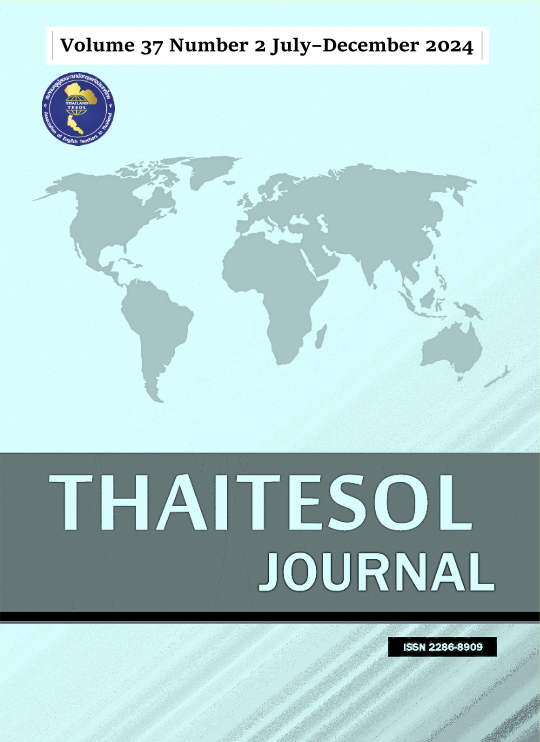Improving the English-Language Academic Paraphrasing Guidelines Taught at a Thai University
Main Article Content
Abstract
This case study investigates the effectiveness of paraphrasing guidelines taught in a graduate academic and research writing class at a Thai university. It evaluates the use of paraphrasing strategies, as taught through the guidelines, by students when paraphrasing English-language sources. The assessment considers the students’ utilization of these strategies while employing all available resources, which is the typical approach in academic writing. A pretest/posttest task was administered to determine the improvement, if any, in key paraphrasing strategies among the 12 students enrolled in the course. Background information was collected through a questionnaire before the pretest, and face-to-face interviews were conducted after the posttest. Although students demonstrated significant improvement in almost all strategies, it was identified that explicit instruction should be increased, particularly in skills related to reordering words, such as changing sentence structures, as well as adding text by conveying the same meaning in their own words. Additionally, a moderate emphasis on instruction could be placed on strategies related to changing words, such as finding synonyms. Other skills, notably citing, require no further emphasis. Based on the results, recommendations are provided for enhancing the guidelines, and suggestions are offered for instructors looking to refine their own writing courses that incorporate paraphrasing.
Article Details

This work is licensed under a Creative Commons Attribution-NoDerivatives 4.0 International License.
Materials in THAITESOL JOURNAL may be photocopied for educational purposes. Under no circumstances may any part of this journal be photocopied for commercial purposes.
References
Arifuddin, A. (2021). The effect of thesis writing on paraphrasing ability of the EFL alumni of the University of Mataram Lombok. Indonesian Journal of EFL and Linguistics, 411–431. https://doi.org/10.21462/ijefl.v6i2.392
Bakhtiyari, K., Salehi, H., Embi, M. A., Shakiba, M., Zavvari, A., Shahbazi-Moghadam, M., ... & Mohammadjafari, M. (2014). Ethical and unethical methods of plagiarism prevention in academic writing. International Education Studies, 7(7), 52–62.
Campbell, C. (1990). Writing with others’ words: Using background reading text in academic compositions. In B. Kroll (Ed.), Second language writing: Research insights for the classroom (pp. 211–30). Cambridge University Press.
Chen, M. H., Huang, S. T., Chang, J. S., & Liou, H. C. (2015). Developing a corpus-based paraphrase tool to improve EFL learners’ writing skills. Computer Assisted Language Learning, 28(1), 22–40. https://doi.org/10.1080/09588221.2013.783873
Flowerdew, J., & Li, Y. (2007). Plagiarism and second language writing in an electronic age. Annual Review of Applied Linguistics, 27, 161–183. https://doi.org/10.1017/S0267190508070086
Keck, C. (2006). The use of paraphrase in summary writing: A comparison of L1 and L2 writers. Journal of Second Language Writing, 15, 261–278. https://doi.org/10.1016/j.jslw.2006.09.006
Keck, C. (2014). Copying, paraphrasing, and academic writing development: A reexamination of L1 and L2 summarization practices. Journal of Second Language Writing, 25, 4–22. https://doi.org/10.1016/j.jslw.2014.05.005
Leask, B. (2006). Plagiarism, cultural diversity and metaphor—implications for academic staff development. Assessment & Evaluation in Higher Education, 31(2), 183–199. https://doi.org/10.1080/02602930500262486
Mozgovoy, M., Kakkonen, T., & Sutinen, E. (2007). Using natural language parsers in plagiarism detection. In Workshop on Speech and Language Technology in Education.
Na, C. D., & Nhat Chi Mai, N. X. (2017). Paraphrasing in academic writing: A case study of Vietnamese learners of English. Language Education in Asia, 8(1), 9–24. http://dx.doi.org/10.5746/LEiA/17/V8/I1/A02/Na_Mai
Neumann, H., Leu, S., McDonough, K., & Crawford, B. (2020). Improving students’ source integration skills: Does a focus on reading comprehension and vocabulary development work?. Journal of English for Academic Purposes, 48, 100909. https://doi.org/10.1016/j.jeap.2020.100909
Readable. (n.d.). Flesch reading ease. https://charactercalculator.com/flesch-reading-ease/
Rinnert, C., & Kobayashi, H. (2005). Borrowing words and ideas: Insights from Japanese L1 writers. Journal of Asian Pacific Communication, 15, 31–56.
Shi, L. (2006). Cultural backgrounds and textual appropriation. Language Awareness, 15, 264–282.
Shi, L. (2012). Rewriting and paraphrasing source texts in second language writing. Journal of Second Language Writing, 21(2), 134–148. https://doi.org/10.1016/j.jslw.2012.03.003
Tran, T. T. T., & Nguyen, H. B. (2022). The effects of paraphrasing on EFL students’ academic writing. Journal of Language and Linguistic Studies, 18(1), 976–987.
Valentine, K. (2006). Plagiarism as literacy practice: Recognizing and rethinking ethical binaries. College Composition and Communication, 58, 89–100. https://www.jstor.org/stable/20456924
Yahia, I. A. (2020). How university-level English language learners learn to paraphrase. [Doctoral dissertation, Washington State University].
Yahia, I., & Egbert, J. L. (2023). Supporting non-native-English speaking graduate students with academic writing skills: A case study of the explicit instructional use of paraphrasing guidelines. Journal of Writing Research, 14(3), 305–341. https://doi.org/10.17239/jowr-2023.14.03.01


